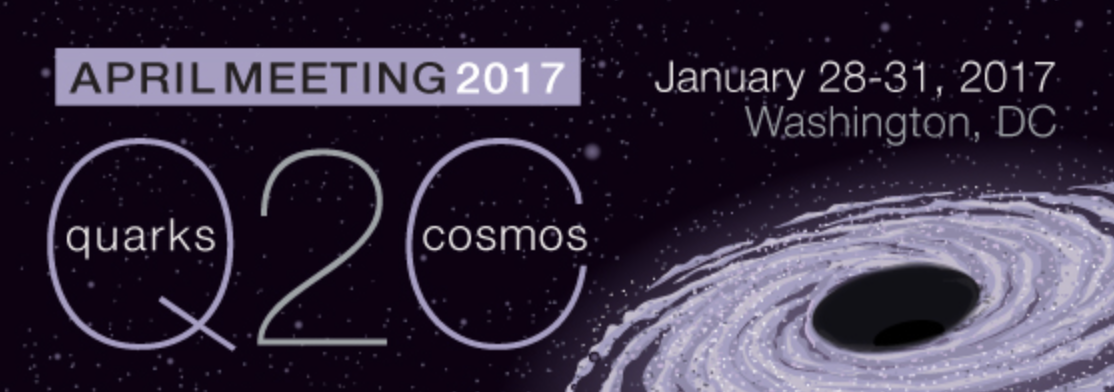APS April meeting highlights: IceCube results on neutrino oscillations and WIPAC talks

The American Physical Society meeting on astronomy, astrophysics, cosmology and particle physics, the so-called April meeting, closes today in Washington DC. The IceCube Collaboration has presented brand new results on neutrino oscillations that are comparable in precision to long-baseline neutrino experiments. From WIPAC, many PhD students and more senior staff presented results about IceCube, including the masterclass, along with results on CTA and Fermi.
The neutrino oscillation study is an update to a previous paper published by the collaboration in 2015. Now, with a more efficient selection and an improved reconstruction, IceCube has presented the most precise measurement of the oscillation parameters at high energies, i.e., tens of GeV and above. This provides a test of the standard neutrino oscillation paradigm, so far based on precise measurements at lower energies. The results have added support to the maximal mixing model, where a neutrino mass eigenstate may comprise exactly equal amounts of only two neutrino flavors. T2K had previously favored maximal mixing, while experiments like NOvA and MINOS do not. Scientists expect that a precise measurement of all neutrino oscillation parameters could shed light on the origin of the matter-antimatter asymmetry.
Carlos Argüelles, currently an MIT postdoc, was one of the finalists for the outstanding doctoral thesis award in astrophysics. His nomination recognized his work at WIPAC, co-leading a sterile neutrino search in IceCube.
A brief summary of talks by WIPAC researchers and staff follows:
- Ali Kheirandish presented the prospects for detecting galactic neutrino sources, a study done in collaboration with Francis Halzen, IceCube PI and WIPAC faculty member, and Vivana Niro from the Universidad Autónoma in Madrid, Spain.
- In a session chaired by Justin Vandenbroucke on neutrino instruments, science and modeling, Kyle Jero presented an improved selection for searches of astrophysical neutrinos from the Southern Hemisphere based on the starting track selection that led to the discovery of astrophysical neutrinos and using the high-quality directional information of muon neutrinos.
- In the same session, Zach Griffith presented work performed in collaboration with Hershal Pandya from the University of Delaware to search for PeV gamma rays using both the IceTop and IceCube detectors.
- In a session about multimessenger astronomy, Justin Vandenbroucke explained how the detection of gamma rays between tens of GeV and hundreds of TeV in the future CTA observatory will allow follow-up of transient events detected in other wavelengths and messengers, including neutrinos and grativational waves.
- In another session about cosmic-ray anisotropy (CR) and ground-based observations, Matthew Meehan presented a study of the anisotropy using the Fermi Large Area Telescope (LAT). The Fermi group at WIPAC is led by Justin Vandenbroucke, also a co-author of this study.
- In the same session, Michael Lukasik presented a study of the CR anisotropy with IceCube. This work focuses on the effects of the time dependence of the sidereal anisotropy on the solar dipole anisotropy.
- Miles Winter presented a study estimating the GeV emission of millisecond pulsars in dwarf spheroidal galaxies using Fermi LAT on a session about dwarf galaxies, dark matter, and magnetic fields. This research was done in collaboration with Justin Vandenbroucke, former WIPAC postdoc Keith Bechtol, and Gabrijela Zaharijas from the Instituto Nazionale di Fisica Nucleare.
- Donglian Xu presented a search for neutrino emission from fast radio bursts with IceCube, a study co-authored by Justin Vandenbroucke, Samuel Fahey, and Ali Kheirandish.
- Kevin Ghorbani presented a new search for sterile neutrinos using starting events in IceCube. The preliminary results from a 10% burn sample show a sensitivity comparable to previous searches in IceCube.
- Sílvia Bravo showed a few highlights of the IceCube Masterclass, focusing on what we have learned from the evaluation of the program and that point to the masterclass as a great program to attract students from underrepresented audiences in STEM.
+ info Press release by MSU: ‘Ghost particles’ could improve understanding the universe
